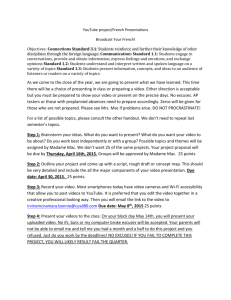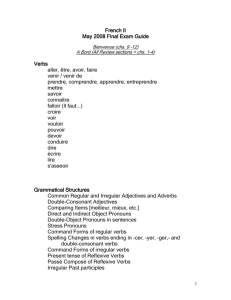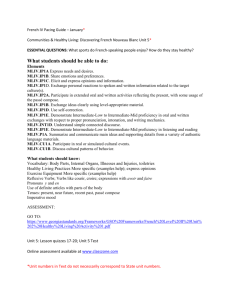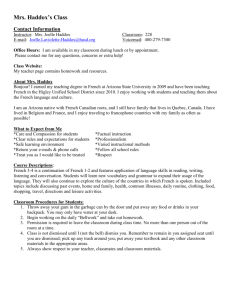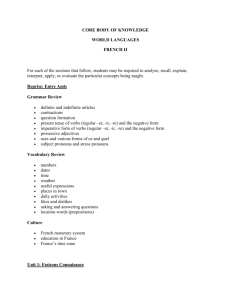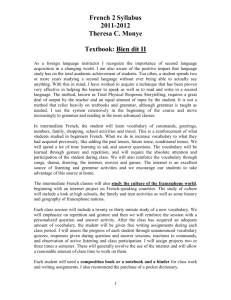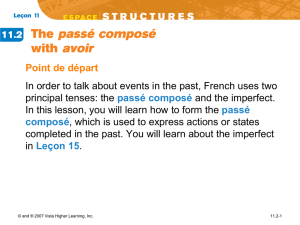FRE 1121 - Florida State College at Jacksonville
advertisement
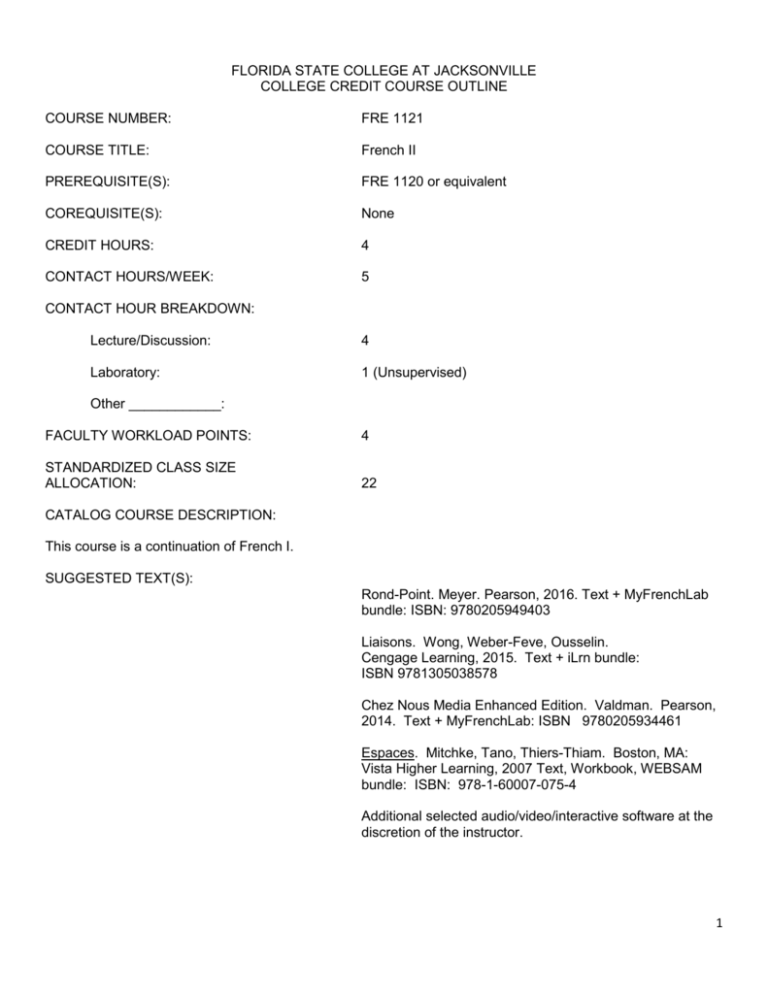
FLORIDA STATE COLLEGE AT JACKSONVILLE COLLEGE CREDIT COURSE OUTLINE COURSE NUMBER: FRE 1121 COURSE TITLE: French II PREREQUISITE(S): FRE 1120 or equivalent COREQUISITE(S): None CREDIT HOURS: 4 CONTACT HOURS/WEEK: 5 CONTACT HOUR BREAKDOWN: Lecture/Discussion: 4 Laboratory: 1 (Unsupervised) Other ____________: FACULTY WORKLOAD POINTS: 4 STANDARDIZED CLASS SIZE ALLOCATION: 22 CATALOG COURSE DESCRIPTION: This course is a continuation of French I. SUGGESTED TEXT(S): Rond-Point. Meyer. Pearson, 2016. Text + MyFrenchLab bundle: ISBN: 9780205949403 Liaisons. Wong, Weber-Feve, Ousselin. Cengage Learning, 2015. Text + iLrn bundle: ISBN 9781305038578 Chez Nous Media Enhanced Edition. Valdman. Pearson, 2014. Text + MyFrenchLab: ISBN 9780205934461 Espaces. Mitchke, Tano, Thiers-Thiam. Boston, MA: Vista Higher Learning, 2007 Text, Workbook, WEBSAM bundle: ISBN: 978-1-60007-075-4 Additional selected audio/video/interactive software at the discretion of the instructor. 1 IMPLEMENTATION DATE: Winter Term, 1996 (962) REVIEW OR MODIFICATION DATE: January, 1999 Fall Term, 2002 (20031) Fall Term, 2008 (20091) – Outline Review 2007 Fall Term, 2015 (20161) – Proposal 2014-101 Fall Term, 2015 (20161) – Proposal 2015-19 Fall Term, 2015 (20161) – Outline Review 14-15 2 COURSE TOPICS: TOPICS MAY BE ARRANGED TO ACCOMMODATE PROFESSOR'S INDIVIDUAL PREFERENCE AND TECHNIQUE I. II. Introduction to Course and Review A. Review of basic sound system, pronunciation and intonation. B. Review of structures studied in FRE 1120, Instructional Unit 6 A. 2 8 Structures and Communicative Goals 1. 2. 3. 4. 5. 6. 7. 8. Talking about parties and celebrations Talking about stages of life Demonstrative pronouns Passé composé with avoir Talking about clothing and shopping Colors Indirect object pronouns Regular and irregular –re verbs III. Instructional Unit 7 A. APPROXIMATE NUMBER OF CONTACT HOURS PER UNIT 8 Structures and Communicative Goals 1. 2. 3. 4. 5. 6. 7. 8. 9. Talking about travel and vacation Names of countries and nationalities Passé composé with être Direct object pronouns Talking about hotels and reservations Ordinal numbers Regular –ir verbs Commands Verbs dire, écrire, lire, décrire 3 COURSE TOPICS: TOPICS MAY BE ARRANGED TO ACCOMMODATE PROFESSOR'S INDIVIDUAL PREFERENCE AND TECHNIQUE APPROXIMATE NUMBER OF CONTACT HOURS PER UNIT IV. Instructional Unit 8 A. Structures and Communicative Goals 1. 2. 3. 4. 5. 6. V. 10 Structures and Communicative Goals 1. 2. 3. 4. 5. VII. Talking about food and meals Verb: venir The passé récent Time expressions: depuis, pendant, il y a Verbs : devoir, vouloir, pouvoir Terms for eating in a restaurant, specialty food shops Comparison and superlatives Double object pronouns Instructional Unit 10 A. 10 Structures and Communicative Goals 1. 2. 3. 4. 5. 6. 7. 9. VI. Parts of the house Adverbs Imparfait Terms for household chores and appliances Passé composé v. imparfait Uses of savoir v. connaître Instructional Unit 9 A. 12 Parts of the body One’s daily routine / reflexive verbs Describing one’s health Passé composé of reflexive verbs Pronouns y and en Instructional Unit: Review and Practice 5 This unit should be used for application and consolidation of previously studied material. It also allows for additional cultural presentations and student projects. VIII. Instructional Unit: Review and Testing 5 This unit should be used for periodic reviews, quizzes and exams. 4 IX. Additional Activities and Review: Additional activities are at the discretion of the instructor. They may include readings (in the text or from other sources) and other classroom proficiency-oriented activities and/or projects. Supportive language lab exercises are provided for each topic to be accomplished by students on an individual basis in the language lab. COLLEGE-LEVEL ACADEMIC SKILLS: A. To develop aural comprehension of simple factual material. B. To continue practice of pronunciation and intonation patterns. C. To expand oral communication skills. D. To cover most of the essential grammatical structures. E. To develop reading skills (from working with previously known material to working with new material) and vocabulary. F. To develop writing skills (from working with previously known patterns and simple sentences to the writing of original paragraphs with minimal error, to the writing of short compositions in good style with minimal error.) G. To continue to expand knowledge of and appreciation for Francophone cultures. 5 ACTFL PROFICIENCY GUIDELINES The 1986 proficiency guidelines developed by the American Council for the Teaching of foreign languages with grants from the U.S. Department of Education represent a hierarchy of global characterizations of integrated performance in speaking, listening, reading and writing. Each description is a representative, not an exhaustive, sample of a particular range of ability, and each level subsumes all previous levels, moving from simple to complex in an "all-before-and-more" fashion. SPEAKING Intermediate-Low Able to handle successfully a limited number of interactive, task-oriented and social situations. Can ask and answer questions, initiate and respond to simple statements and maintain face-to-face conversations, although in a highly restricted manner and with much conversations, although in a highly restricted manner and with much linguistic inaccuracy. Within these limitations, can perform such tasks as introducing self, ordering a meal, asking directions, and making purchases. Vocabulary is adequate to express only the most elementary needs. Strong interference from native language may elementary needs. Strong interference from native language may occur. Misunderstandings frequently arise, but with repetition, the Intermediate-Low speaker can generally be understood by sympathetic interlocutors. LISTENING Intermediate-Mid Able to understand sentence-length utterances which consist of recombinations of learned elements in a limited number of content areas, particularly if strongly supported by the situational context. Content refers to basic personal background and needs, social conventions and routine tasks, such as getting meals and receiving simple instructions and directions. Understanding is often uneven; repetition and rewording may be necessary. Misunderstandings in both main ideas and details arise frequently. Intermediate-Mid Able to understand sentence-length utterances which consist of recombinations of learned utterances on a variety of topics. Content continues to refer primarily to basic personal background and needs, social conventions, and somewhat more complex tasks, such as lodging, transportation, and shopping. Additional content areas include some personal interests and activities, and a greater diversity of instructions and directions. Listening tasks not only pertain to spontaneous face-to-face conversations but also to short routine telephone conversations and media. Understanding continues to be uneven. READING Intermediate-Mid Able to read consistently with increased understanding simple connected texts dealing with a variety of basic and social needs. Such texts are still linguistically non-complex and have a clear underlying internal structure. They impart basic information about which the reader has to make minimal suppositions and to which the reader brings personal interest and/or knowledge. Examples may include short, straightforward descriptions of persons, places, and things written for a wide audience. 6 WRITING Intermediate-Low Able to meet limited practical writing needs. Can write short messages, postcards, and take down simple notes, such as telephone messages. Can create statements or questions within the scope of limited language experience. Material produced consists of recombinations of learned vocabulary and structures into simple sentences on very familiar topics. Language is inadequate to express in writing anything but elementary needs. Frequent errors in grammar, vocabulary, punctuation, and spelling and in formation of non-alphabetic symbols occur, but writing can be understood by natives used to the wringing of non-natives. 7 Florida State College at Jacksonville Course Learning Outcomes and Assessment SECTION 1 Course Prefix and Number: FRE 1121 Course Title: French II Semester Credit Hours (Credit): Contact Hours (Workforce): 4 SECTION 2a (To be completed for General Education courses only.) TYPE OF COURSE (Place an “X” in the box next to those that are applicable.) General Education Core (If selected, core discipline area will be identified in Section 4.) General Education (If selected, you must also complete Section 4, Section 5, and Section 8) SECTION 2b TYPE OF COURSE (Place an “X” in the box next to those that are applicable.) X A.A. Elective A.S. Required Course A.S. Professional Elective A.A.S. Required Course A.A.S. Professional Elective Technical Certificate PSAV/Clock Hour/Workforce Upper Division/Bachelors Development Education Apprenticeship Other: If selected, use this space to title “other” option. SECTION 3 INTELLECTUAL COMPETENCIES (Place an “X” in the box next to those that are applicable.) X Reading X Speaking Critical Analysis Qualitative Skills X Writing X Listening Information Literacy Ethical Judgement Scientific Method of Inquiry Working Collaboratively SECTION 4 (To be completed for General Education courses only.) GENERAL EDUCATION DISCIPLINE AREA (Place an “X” in the box next to those that are applicable.) Communications Humanities Mathematics Social and Behavioral Sciences Natural Sciences SECTION 5 (To be completed for General Education courses only.) GENERAL EDUCATION LEARNING OUTCOME AREA (Place an “X” in the box next to those that are applicable.) Communication Critical Thinking Information Literacy Scientific and Quantitative Reasoning Global Sociocultural Responsibility SECTION 6 LEARNING OUTCOMES Be able to speak at the Intermediate-low level according to the ACFTL Guidelines. Be able to listen at the Intermediate-mid level according to the ACTFL Guidelines. Be able to read consistently at the Intermediatemid level according to ACTFL Guidelines. TYPE OF OUTCOME (General Education, Course or Program) METHOD OF ASSESSMENT Course Performance-based assessments Course Quizzes, tests, listening comprehension assignments Course Quizzes, tests, performance questions 8 SECTION 6 LEARNING OUTCOMES TYPE OF OUTCOME (General Education, Course or Program) METHOD OF ASSESSMENT Be able to write at the Intermediate-low level according to ACTFL Guidelines. Course Quizzes, tests, written assignments SECTION 7 Faculty name(s): John Fields Date: 4/16/2015 CS20150615 9
